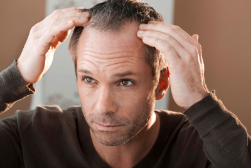
Most of men experience hair loss, starting from the age of late 20’s and progressing at 50’s. Several factors; such as the frequency of hair wash, skin disorders, infections, malnutrition and medications may lie behind the hair loss in men, but it is mostly secondary to genetic factors.
Testosterone, male hormone, is responsible for hair loss that is secondary to genetic factors. This hormone interacts with 5-Alpha-Reductase enzyme that exists in the capillary bulb and converts into dihydrotestosterone (DHT). DHT leads to thinning and eventually loss of hair. This type of hair loss is called "androgenic alopecia (AGA)”. The up-to-date medical opinion is that many genes play a role in the development of AGA. To date, eight suspected areas on x-chromosome, which include the segment where the androgen gene receptor is coded, are reported. Recent studies claim some interesting genetic links between the early-onset AGA and some other major diseases, but these links have not been proven yet. Besides, it has been proven that increases in Prostaglandin D2 level are also responsible for AGA-type hair loss.
AGA (Androgenic Alopecia) is the most common cause of hair loss among men. Colloquially, the male-pattern hair loss is also known as "ordinary baldness” and “male hair loss”. This type of hair loss develops secondary to the transformation of testosterone, the most active and dominant hormone, into dihydrotestosterone by 5-alpha-reductase enzyme that exists in hair root and the response of hair root to this phenomenon. It generally starts on bilateral temples and is followed by hair loss on vertex and frontal region. In the course of this process, hair gets thinner and weaker. Thick and strong roots turn into babyish thin hair that is hardly noticeable; this phenomenon is called miniaturization. And next, this is followed up by hair loss.
Hair loss and baldness causes a severe stress on individuals and creates negative outcomes that directly affect people’s lives. Patients start losing their self-esteem due to hair loss. Our patients frequently tell our physicians: “I’ve got my self-esteem back.” Androgenic alopecia is seen in half of men who are 50 years old.
This disease is diagnosed with simple tests that are performed in the examination. It is possible to stop or slow down these hair loss problems with proper treatment and procedures.
CLASSIFICATION
Norwood Classification is used.

Use of hair care products for hair follicles may prevent hair loss in men. However, such personal products do not help hair loss with a genetic background; for such cases, the best approach will be a personalized solution that is reached by physicians by taking into consideration the family history, eating habits and sleep pattern. Some treatments for hair loss are listed below.
Finasteride is a treatment that aims prevention of hair loss by repairing the thin/weak hair. It is listed among the FDA-approved treatment methods for hair loss. It suppresses the 5-alpha-reductase enzyme and prevents the synthesis of DHT. Finasteride helps you get healthy and viable hair by eliminating the negative effects of testosterone on hair follicles. It is very effective in protecting and strengthening the remaining hair even though baldness has already developed in some regions. Finasteride has an extremely low side effect profile; even though there are some adverse effects reported by some patients who used this medication, scientific studies could not demonstrate significant differences between control and placebo groups.
PRP (Platelet-Rich Plasma) is one of the FDA-approved treatments for the male-pattern hair loss. It involves separating the platelet-rich fraction of the blood drawn from the patient and injecting it to the scalp. Factors and enzymes secreted by platelets strengthen and protect hair. This treatment aims to make hair follicles stronger and slow down the hair loss. Even though there is interpersonal variation in the frequency of use, physicians usually prefer one session per month.
Mesotherapy is one of the treatments available for the male-pattern hair loss and it involves injecting some compounds such as vitamins, minerals, amino acid and growth factors into scalp in order to increase metabolic rate and invigorate hair. Even though there is interpersonal variation in the frequency of use, it is usually applied in one session per month. It can be considered as a supportive treatment for the hair transplant. Very successful outcomes are obtained, when it is combined with PRP.
These treatments for hair loss in men are not the absolute solution for the hair loss secondary to genetic factors. Hair transplant surgery is the most effective and recognized method against hair loss. Other treatments may be considered to support the outcomes of a hair transplant surgery.
Hair loss may impair self-esteem in men. People may develop anxiety and get stressed due to hair loss. They may isolate themselves from their social circle. In addition, they may experience lack of sexual appetite and depression.
At this point, the most important step for these people is to confront the hair loss and accept this disease, which is seen in almost half of the men. Psychological support may also be recommended for the men who are suffering from this condition. Another solution would be hair transplant, which is a permanent solution. Hair transplant restores person’s self-esteem.
Hair transplant is among the most commonly preferred treatment modality for patients with male-pattern hair loss to get healthy hair. Success rate of hair transplant is quite high in men.
Hair transplant in men is performed with two different methods; FUE and FUT. FUE technique is far more popular due to its certain advantages such as quicker post-operative recovery and absence of scar formation.
In hair transplant, successful results become visible in the long-term. Therefore, this process requires patience. Moreover, there are many issues to be considered in the pre-operative and post-operative periods. For further details about hair transplant, you may read our article “Hair Transplant Surgery” or contact us through our website.